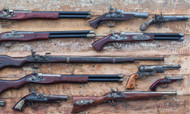The Evolution of Steel: Why Modern Firearm Barrels Last Longer and Shoot Straighter
Posted by Arms Protection on Oct 10th 2025
Your rifle's barrel is the heart of its performance, enduring thousands of rounds, intense heat, and corrosive gases. While the basic concept—a tube to direct a projectile—is ancient, the materials science and manufacturing techniques used today are anything but.
Modern barrels last longer, resist corrosion better, and deliver superior accuracy than ever before. If you're looking to buy a new firearm or upgrade your existing platform, understanding what makes a modern barrel special is the key to maximizing your investment.
Here's a deep dive into the three critical elements that define a high-performance modern barrel: Material, Lining, and Rifling Method.
1. Barrel Steel: The Foundation of Performance
Modern barrels are typically made from one of two primary steel alloys, each optimized for different priorities: durability or precision.
Chrome-Moly Steel (4140/4150 CrMoV)
Chrome Molybdenum Vanadium (CrMoV) steel, often simply called "chrome-moly," is the traditional workhorse alloy.
- Priority: Durability, toughness, and cost-effectiveness.
- Best For: Hard-use, high-volume shooting, and military applications (Mil-Spec 4150 is the standard for AR-15s).
- The Trade-off: Requires specialized internal finishes to resist rust and bore wear.
Stainless Steel (416R)
Stainless steel, particularly the 416R alloy, is the choice of many competitive and precision shooters.
- Priority: Accuracy and Corrosion Resistance.
- Best For: Precision shooting, hunting in humid or wet environments, and match-grade rifles.
- The Trade-off: Generally costs more, but often machines with a smoother internal finish, giving it the edge in potential out-of-the-box accuracy.
>> Looking for a specific barrel material? Browse our selection of rifle and AR-15 barrels and filter by steel type.
Shop Firearm Barrels
2. Rifling: How Barrels Spin Bullets
The barrel's rifling—the helical grooves that impart a stabilizing spin to the bullet—is created through sophisticated manufacturing methods, with each approach optimizing for longevity or maximum precision.
Cold Hammer Forging (CHF)
In this process, the barrel blank is hammered around a mandrel (a rod with the inverse shape of the rifling). This high-pressure technique densifies the steel, creating an extremely durable, long-lasting barrel with a superb internal finish.
- Pros: Superior longevity, excellent grain structure, and high resistance to throat erosion. It's tough as nails, making it ideal for military and high-round-count platforms.
Button Rifling
This is the most common method for mass-produced and custom barrels. A carbide button is forced or pulled through the bore in a single pass, swaging (displacing) the steel to form the rifling grooves.
- Pros: Economical and fast to produce, capable of excellent accuracy (many bench-rest records are held by button-rifled barrels).
3. Surface Treatments: The Durability Battle
Modern barrels rely on advanced treatments to protect the bore, reduce friction, and extend service life far beyond bare steel. The two major players are Chrome Lining and Nitriding.
Chrome Lining
This traditional military finish adds a coating of hard, anti-corrosive chrome inside the bore and chamber.
- Best For: Extreme heat and high-volume abuse. Chrome is highly heat-resistant, making it the choice for machine guns and rifles subjected to full-auto fire.
- The Trade-off: The process can sometimes compromise ultimate precision compared to an unlined or nitrided barrel.
Nitriding (Melonite/QPQ)
Nitriding is a modern chemical process that changes the surface composition of the steel itself by diffusing nitrogen and carbon into the metal. It is not a coating that can flake off.
- Best For: Corrosion resistance and accuracy. Nitride treatments result in superior external and internal corrosion protection. Because it doesn't add material, nitriding maintains the original dimensional accuracy of a finely machined bore.
| Feature | Chrome Lining | Nitriding (QPQ) |
|---|---|---|
| Process | Adds a coating (hard chrome). | Diffuses chemical elements into the steel surface. |
| Corrosion | Excellent on bore/chamber. | Excellent on entire barrel (inside and out). |
| Best For | Extreme heat, full-auto fire, maximum longevity. | Optimal accuracy, corrosion resistance, general civilian use. |
4. Barrel Twist Rate: Matching the Spin to the Bullet
No matter how high-tech your barrel is, its performance relies entirely on the correct Rifling Twist Rate (e.g., 1:7, 1:9). The twist rate dictates how fast the rifling spins the projectile.
The critical rule to remember: Longer and heavier bullets require a faster twist rate for stability.
| Twist Rate | Best for Bullet Weight (5.56/.223) | Application |
|---|---|---|
| 1:7 | 69 Grains and heavier (up to 90gr) | Military/long-range match shooting. |
| 1:8 | 60 to 80 Grains (Most versatile) | General-purpose carbine, most common twist rate today. |
| 1:9 | 45 to 77 Grains | Mid-range compromise, excellent for common 55gr plinking ammo. |
Using a slow twist (e.g., 1:12) with a heavy, long bullet can cause the bullet to tumble or "keyhole." Matching the right ammunition to your barrel's twist rate is paramount.
>> Check your rifle’s specs and ensure you’re using the optimal ammunition weight for your twist rate.
Browse Rifle Ammunition
Modern barrels are technological marvels. Whether you prioritize the match-grade accuracy of Stainless Steel or the relentless durability of Chrome-Lined CHF barrels, you'll find the best options built with these advanced techniques.
Ready to select the next level of accuracy and durability for your rifle?

